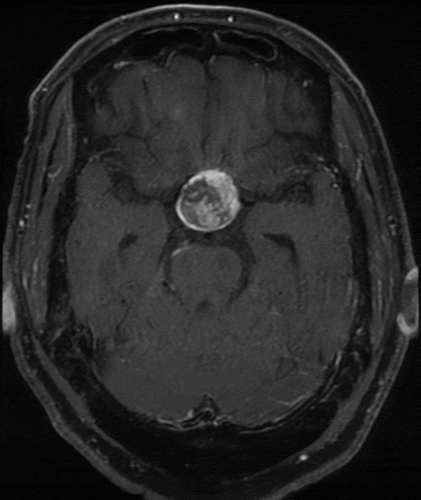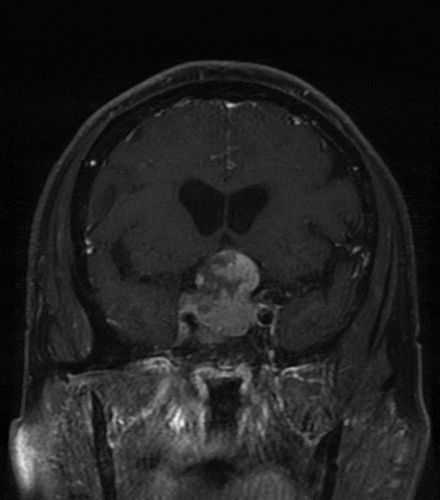ABSTRACT
Pituitary apoplexy is a life-threatening complication that may result from hemorrhage or infarction of a pituitary adenoma. Neuroimaging may reveal a snowman-like or ‘figure of 8ʹ configuration as a result of bilateral indentation of the tumor by the sellar diaphragm.
1. case presentation
A 59-year-old male with a past medical history significant for hypertension and glaucoma presented to the emergency department with a 3-day history of worsening headache, altered mental status, and complete loss of vision. Physical examination revealed a temperature of 102.0 F, binocular blindness, as well as right third nerve palsy. MRI of the brain without contrast showed a large expansile sellar and suprasellar hemorrhagic mass with a bilobed or snowman configuration. () The mass invaded the right cavernous sinus with encasement of the cavernous portion of the internal carotid artery and placed a mass effect on the optic chiasm. A hormonal profile showed a TSH of 0.0069 uIU/ml (0.358–3.740), LH <0.2 mIU/ml (1.5–9.3), ACTH 12 pg/ml (6–50), cortisol AM 1.3 mcg/dl (4–22), prolactin 5 ng/ml (2–18) and GH 0.2 ng/ml (<7.1). The patient was started on IV dexamethasone. He underwent a left frontotemporoparietal craniotomy with excision of the mass. Pathology report later confirmed the diagnosis of pituitary adenoma. Postoperatively, there was no improvement in visual acuity. The patient required lifelong replacement with levothyroxine, hydrocortisone, desmopressin, and testosterone to treat panhypopituitarism.
2. Discussion
Pituitary macroadenomas are the most common suprasellar masses in adults and account for about 10% of all intracranial neoplasms. They are slow-growing and may expand the bony sella and extend superiorly into the suprasellar cistern to compress the optic chiasm. Their classic appearance on neuroimaging is a snowman-like or ‘figure of 8’ configuration as a result of bilateral indentation of the tumor by the rigid dura of the diaphragma sellae. Meningiomas arising from the sellar diaphragm may resemble pituitary neoplasms but can be seen separate from the pituitary gland. Other differentials for suprasellar masses include craniopharyngiomas and aneurysms of the parasellar internal carotid artery [Citation1].
Pituitary apoplexy is usually seen in the context of a pituitary macroadenoma and is a rare, potentially fatal condition that results from hemorrhage or infarction of the pituitary gland. Headache is the most common symptom followed by visual deficits mainly in the form of bitemporal hemianopsia. Loss of visual acuity and complete blindness are rare [Citation2]. Fever may be seen in some cases, and, in the setting of meningeal irritation, may lead to a misdiagnosis of meningoencephalitis [Citation3]. Central hypoadrenalism may be seen in seventy percent of patients and empiric steroids should be administered as soon as the diagnosis is confirmed. Other apoplexy-related hormonal deficiencies may be observed, with TSH and gonadotrophin deficiencies seen in 50–70% of patients [Citation4].
Disclosure statement
No potential conflict of interest was reported by the authors.
Additional information
Funding
References
- Pisaneschi M, Kapoor G. Imaging the sella and parasellar region. Neuroimaging Clin N Am. 2005 Feb;15(1):203–219. PMID: 15927868.
- Briet C, Salenave S, Bonneville JF, et al. Pituitary Apoplexy. Endocr Rev. 2015 Dec;36(6):622–645. Epub 2015 Sep 28. PMID: 26414232.
- Oh K, Kim JH, Choi JW, et al. Pituitary apoplexy mimicking meningitis. Brain Tumor Res Treat. 2013 Oct;1(2):111–115. Epub 2013 Oct 31. PMID: 24904903; PMCID: PMC4027104.
- Albani A, Ferraù F, Angileri FF, et al. Multidisciplinary management of pituitary apoplexy. Int J Endocrinol. 2016;2016:7951536. Epub 2016 Dec 15. PMID: 28074095; PMCID: PMC5198093.


